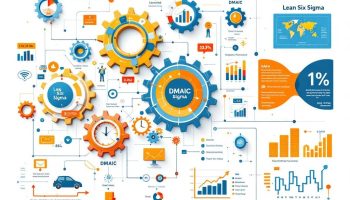
Supply chain optimization creates a methodical framework for boosting efficiency throughout your organization’s supply chain network. By applying targeted improvements to procurement, inventory, transportation, and distribution processes, you’ll develop a more resilient and responsive supply ecosystem that adjusts quickly to market demands.
Why Supply Chain Optimization Is Critical for Business Success
Supply chain optimization directly impacts your company’s bottom line by cutting operational costs while enhancing customer satisfaction and market competitiveness. These strategies reduce inventory carrying costs, prevent stockouts, speed up order fulfillment, and strengthen your defense against disruptions. In today’s unpredictable business landscape, companies that excel at supply optimization gain substantial competitive advantages through better cash flow, superior customer experiences, and the agility to adapt to market shifts—converting supply chains from expense centers into strategic assets that fuel growth.
Effective supply chain management can reduce costs by up to 15% while increasing customer satisfaction by 20%.
Transform Your Business Operations
Supply chain optimization transforms your business operations, directly boosting profitability and customer satisfaction. This strategic approach eliminates waste, cuts costs, and enhances service delivery throughout your organization. Companies implementing effective supply chain optimization typically achieve 15-30% cost reductions while improving delivery performance.
Creating a Responsive System
Optimizing your supply chain isn’t just about cost-cutting—it’s about creating a responsive system that adapts to market fluctuations and customer needs. This process addresses everything from supplier relationships to inventory control, turning necessary logistics into a competitive edge.
Building Operational Excellence
A systematic approach to supply optimization builds a foundation for ongoing improvement and operational excellence. Your optimized supply chain will become more agile and cost-effective, ready to respond to changing demands while maintaining quality and reliability.
1. Identify and Track Essential KPIs for Supply Optimization
Effective supply chain optimization begins with measuring what matters most. By tracking key performance indicators (KPIs), you can identify areas for improvement and make data-driven decisions to enhance your supply chain efficiency.
Start by monitoring order fulfillment rates to understand how effectively you’re meeting customer demands. This metric directly impacts customer satisfaction and reveals potential bottlenecks in your supply optimization strategy. Inventory turnover rates show how quickly stock moves through your system, helping you balance holding costs against stockout risks.
Transportation costs often represent a significant portion of supply chain expenses, making them crucial for supply optimization efforts. Track these expenses meticulously to identify cost-saving opportunities. Lead times between order placement and delivery affect both customer satisfaction and inventory planning. Effective process improvement in your supply chain requires constant monitoring of these timeframes.
Consider these key metrics to establish your KPI dashboard:
- On-time delivery percentage
- Order accuracy rates
- Inventory carrying costs
- Cash-to-cash cycle time
- Perfect order metrics (complete, accurate, on-time, undamaged)
2. Map Your Current Supply Chain Flow
Effective supply chain optimization begins with a comprehensive understanding of your existing processes. To properly map your current supply chain flow, start by documenting all operational procedures from procurement to delivery. Create detailed flowcharts that visualize how materials and information move through your organization.
Identifying bottlenecks is crucial for supply optimization success. Analyze each stage of your supply chain to pinpoint areas where delays frequently occur or where resources are being underutilized. Look for processes with excessive wait times, quality issues, or capacity constraints that impede optimal flow.
When mapping supplier relationships, document all vendors involved in your supply chain, including:
- Primary suppliers and their capabilities
- Secondary and backup suppliers
- Contract terms and delivery expectations
- Historical performance metrics
- Communication channels and response times
Track product movement by documenting the flow of materials through your entire supply network. Monitor how long products remain at each stage and identify opportunities to reduce transit times. This visibility allows you to implement targeted supply optimization strategies that eliminate inefficiencies while maintaining quality and service levels.
Expert Insight: To optimize your supply chain, start by mapping the entire flow from procurement to delivery with detailed flowcharts. Identify bottlenecks and inefficiencies by analyzing each stage for delays and resource underutilization. Finally, document supplier relationships and monitor product movement to enhance visibility and target optimization strategies effectively.
3. Implement Real-Time Inventory Management
Implementing real-time inventory management is a cornerstone of effective supply chain optimization across your operations. By installing advanced inventory tracking systems, you gain immediate visibility into stock movements and can make data-driven decisions that prevent stockouts and overstock situations. These systems connect your warehouse operations directly to your supply chain, creating a synchronized flow of information.
Setting up automated reordering capabilities further enhances your supply optimization efforts by eliminating manual purchase order creation. When inventory reaches predetermined thresholds, the system automatically generates orders to replenish stock, reducing administrative workload and human error. This automation ensures consistent inventory levels while optimizing the implementation process for your supply chain.
Continuous monitoring of stock levels is essential for maintaining optimal inventory. Regular audits help you:
- Identify slow-moving products
- Recognize seasonal demand patterns
- Adjust safety stock levels appropriately
- Flag potential inventory discrepancies
Warehouse layout optimization completes your real-time inventory management strategy by organizing products according to demand patterns. High-velocity items should be placed in easily accessible locations to improve picking efficiency and reduce travel time for warehouse staff, ultimately streamlining your supply optimization initiatives.
Expert Insight: Implement real-time inventory management to enhance visibility and decision-making, preventing stockouts and overstock issues. Utilize automated reordering to maintain consistent inventory levels and reduce administrative tasks. Optimize your warehouse layout based on demand patterns to improve picking efficiency and streamline your supply chain operations.
4. Leverage Data Analytics Tools for Supply Optimization
To achieve effective supply chain optimization, you need to harness the power of data analytics. By deploying specialized supply chain analytics software, you can gain valuable insights that drive efficiency throughout your operations. These tools help identify patterns, trends, and opportunities that would be impossible to spot manually.
Predictive modeling is a game-changer for supply optimization initiatives. These models analyze historical data and external factors to forecast potential disruptions, allowing you to develop proactive risk responses rather than reactive measures. This forward-thinking approach minimizes costly surprises and maintains service levels.
Implementing demand forecasting tools represents another critical component of supply optimization. These systems help you:
- Anticipate customer needs with greater accuracy
- Reduce excess inventory holding costs
- Prevent stockouts and lost sales opportunities
- Optimize production scheduling
Automated reporting provides stakeholders with real-time visibility into supply chain performance. When you create executive-level reports that highlight key metrics, decision-makers can quickly identify areas needing attention and measure the impact of optimization efforts.
Expert Insight: To optimize supply effectively, leverage data analytics tools that provide insights into patterns and trends. Utilize predictive modeling for proactive risk management and implement demand forecasting to minimize costs and anticipate customer needs. Automated reporting enhances real-time visibility, enabling stakeholders to make informed decisions quickly.
5. Strengthen Supplier Relationships for Supply Optimization
Effective supply chain optimization requires strong partnerships with your vendors. Establishing clear communication protocols creates transparency and prevents misunderstandings that can disrupt your supply chain. Set up regular check-ins, determine preferred communication channels, and clarify response time expectations to ensure everyone stays aligned.
Creating performance metrics helps quantify supplier performance and identify areas for supply optimization. Consider tracking:
- On-time delivery rates
- Quality compliance percentages
- Cost efficiency measurements
- Responsiveness to issues
- Innovation contributions
Developing comprehensive risk management strategies is crucial for supply chain resilience. Work with suppliers to identify potential disruptions and create contingency plans for scenarios like material shortages, transportation delays, or production issues.
Building collaborative partnerships goes beyond transactional relationships. Involve key suppliers in your planning processes, share forecasts, and seek their input on product improvements. When you treat suppliers as strategic partners rather than just vendors, they’ll be more invested in your success. This collaborative approach to supply chain strategies often leads to innovation, cost reductions, and enhanced service levels.
Expert Insight: Strengthen supplier relationships by fostering clear communication and collaboration. Regular check-ins and performance metrics create transparency and accountability, while involving suppliers in planning enhances commitment to mutual success. Treating suppliers as strategic partners leads to innovative solutions, cost savings, and improved service levels in your supply chain.
6. Automate Manual Processes
Automating manual processes is a critical step in achieving supply chain optimization across your operations. By identifying repetitive tasks that consume valuable time and resources, you can implement technology solutions that streamline workflows and reduce errors.
Supply chain optimization benefits significantly from warehouse automation technologies like robotic picking systems, automated guided vehicles, and conveyor systems that accelerate product movement while minimizing labor costs. These systems can reduce picking errors by up to 67% while increasing throughput by 25-50%.
Order processing automation represents another opportunity to enhance supply optimization efforts. Implementing systems that automatically:
- Capture and validate order information
- Check inventory availability
- Process payments
- Generate shipping documentation
- Provide status updates to customers
Digital documentation integration eliminates paper-based processes that slow down your supply chain. By implementing digital documentation systems, you create a centralized information repository that improves data accuracy and accessibility. This approach not only supports supply optimization but also enhances collaboration between departments and external partners.
Mastering Supply Chain Efficiency: Key Takeaways
Supply chain optimization transforms your operations by streamlining processes from procurement to delivery, maximizing efficiency while minimizing costs. This comprehensive approach encompasses tracking essential KPIs, mapping supply chain flows, implementing real-time inventory management, leveraging data analytics, strengthening supplier relationships, and automating manual processes to create a resilient and responsive supply network.
The following table summarizes the six critical steps for achieving maximum supply chain efficiency:
| Step | Key Focus | Primary Benefits |
|---|---|---|
| 1. Track KPIs | Measure performance metrics | Data-driven decision making |
| 2. Map Supply Chain | Visualize process flows | Identify bottlenecks |
| 3. Real-Time Inventory | Automate stock monitoring | Prevent stockouts/overstock |
| 4. Data Analytics | Implement predictive modeling | Anticipate disruptions |
| 5. Supplier Relationships | Establish clear communication | Enhance collaboration |
| 6. Process Automation | Streamline repetitive tasks | Reduce errors and costs |
Steps to Implement Today
- Select 5-7 critical KPIs to track regularly (order fulfillment rates, inventory turnover, transportation costs)
- Create a visual flowchart documenting your entire supply chain from procurement to delivery
- Install inventory tracking software that provides real-time visibility into stock levels
- Set up automated reordering thresholds for your most important products
- Implement a data analytics solution that offers predictive modeling capabilities
- Schedule regular performance reviews with key suppliers to strengthen relationships
- Identify three manual processes that could be automated in the next quarter
- Optimize warehouse layout based on product demand patterns and picking frequency
Frequently Asked Questions
What are the most important KPIs for supply chain optimization? The most critical KPIs include order fulfillment rates, inventory turnover, transportation costs, lead times, on-time delivery percentage, and perfect order metrics that track complete, accurate, undamaged, and on-time deliveries.
How often should I review my supply chain mapping? Review your supply chain mapping quarterly for routine maintenance and immediately after any significant operational changes, new supplier relationships, or market disruptions that affect your business.
What technologies provide the best ROI for supply chain automation? Warehouse management systems, inventory tracking software, automated reordering systems, and robotic picking technologies typically deliver the highest ROI, with many companies seeing 25-50% increases in throughput and up to 67% reductions in picking errors.
How can I improve supplier relationships? Establish clear communication protocols, develop performance metrics, create risk management strategies together, and build collaborative partnerships by involving suppliers in planning processes and treating them as strategic partners rather than just vendors.
Is real-time inventory management necessary for all businesses? While the sophistication level may vary, all businesses benefit from some form of real-time inventory visibility to prevent stockouts, reduce overstock situations, and make data-driven decisions about purchasing and product placement.






